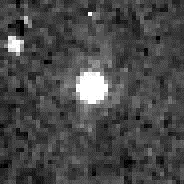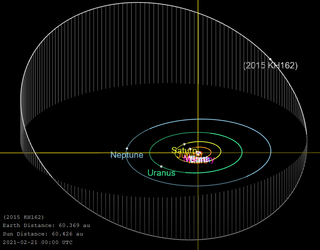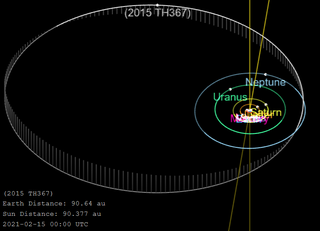Distance
It came to perihelion in 1971 [4] and is currently 51.8 AU from the Sun. [6] In April 2013, it moved beyond 50 AU from the Sun.
It has been observed 81 times over 10 oppositions with precovery images back to 1974. [4]

| Discovery [1] | |
|---|---|
| Discovered by | |
| Discovery date | 30 August 2005 |
| Designations | |
| 2005 QU182 | |
| TNO (SDO) [2] [3] | |
| Orbital characteristics [4] | |
| Epoch 13 January 2016 (JD 2457400.5) | |
| Uncertainty parameter 2 | |
| Observation arc | 13642 days (37.35 yr) |
| Aphelion | 184.19 AU (27.554 Tm) (Q) |
| Perihelion | 36.827 AU (5.5092 Tm) (q) |
| 110.51 AU (16.532 Tm) (a) | |
| Eccentricity | 0.66675 (e) |
| 1161.74 yr (424325.7 d) | |
| 13.854° (M) | |
| 0° 0m 3.054s / day (n) | |
| Inclination | 14.032° (i) |
| 78.395° (Ω) | |
| 223.69° (ω) | |
| Earth MOID | 35.8244 AU (5.35925 Tm) |
| Jupiter MOID | 31.769 AU (4.7526 Tm) |
| TJupiter | 6.711 |
| Physical characteristics | |
| Dimensions | 416±73 km [5] |
| 9.61 h (0.400 d) | |
| 9.61 hr [4] | |
| 0.328+0.160 −0.109 [5] | |
| 20.9 [6] | |
| 3.80±0.32, [5] 3.6 [4] | |
(303775) 2005 QU182 (provisional designation 2005 QU182) is a trans-Neptunian object with a bright absolute magnitude of ca. 3.6. [4]
It came to perihelion in 1971 [4] and is currently 51.8 AU from the Sun. [6] In April 2013, it moved beyond 50 AU from the Sun.
It has been observed 81 times over 10 oppositions with precovery images back to 1974. [4]

(15874) 1996 TL66 (provisional designation 1996 TL66) is a trans-Neptunian object of the scattered disc orbiting in the outermost region of the Solar System.

(612911) 2004 XR190, nicknamed Buffy, is a trans-Neptunian object, classified as both a scattered disc object and a detached object, located in the outermost region of the Solar System. It was first observed on 11 December 2004, by astronomers with the Canada–France Ecliptic Plane Survey at the Mauna Kea Observatories, Hawaii, United States. It is the largest known highly inclined (> 45°) object. With a perihelion of 51 AU, it belongs to a small and poorly understood group of very distant objects with moderate eccentricities.

(145452) 2005 RN43 (provisional designation 2005 RN43) is a classical Kuiper belt object. It has an estimated diameter of 679+55
−73 km. It was discovered by Andrew Becker, Andrew Puckett and Jeremy Kubica on 10 September 2005 at Apache Point Observatory in Sunspot, New Mexico. Brown estimates that it is possibly a dwarf planet.
(120348) 2004 TY364, provisionally known as 2004 TY364, is a trans-Neptunian object. It is an inner classical Kuiper belt object in the definition by Gladman, Marsden, and Van Laerhoven (e<0.24). Its inclination of almost 25 degrees disqualifies it as such in Marc Buie's definition. It is also not listed as a scattered disc object by the Minor Planet Center. It was discovered by Michael E. Brown, Chad Trujillo and David L. Rabinowitz on October 3, 2004 at the Palomar Observatory.
(613766) 2007 NC7, also written as 2007 NC7, is a trans-Neptunian object and centaur from the outer Solar System, approximately 106 kilometers in diameter. It was first observed on 11 July 2007, by American astronomers Megan Schwamb, Michael Brown and David Rabinowitz at Palomar Observatory in California.
(523731) 2014 OK394 (provisional designation 1995 SN55) is a trans-Neptunian object that orbits in the outer Solar System beyond the orbit of Neptune. First observed as 1995 SN55 by Spacewatch on 20 September 1995, it was a lost minor planet with an insufficiently defined orbit with only 36 days of observations. On 8 October 2010, it was rediscovered by the Pan-STARRS 1 survey and later announced as 2014 OK394 in July 2016. It was not until November 2020 when amateur astronomers S. Deen and K. Ly identified 2014 OK394 and 1995 SN55 as the same object. This identification was confirmed and announced by the Minor Planet Center in January 2021.

(528381) 2008 ST291, provisional designation 2008 ST291, is a 1:6 resonant trans-Neptunian object located in the outermost region of the Solar System that takes almost a thousand years to complete an orbit around the Sun. It was discovered on 24 September 2008 by American astronomers Megan Schwamb, Michael Brown and David Rabinowitz at the Palomar Observatory in California, with no known earlier precovery images.

2012 VP113, also known by its nickname "Biden", is a trans-Neptunian object of the sednoid population, located in the outermost reaches of the Solar System. It was first observed on 5 November 2012 by American astronomers Scott Sheppard and Chad Trujillo at the Cerro Tololo Inter-American Observatory in Chile. The discovery was announced on 26 March 2014. The object probably measures somewhere between 300 and 1000 km in diameter, possibly large enough to be a dwarf planet.

2015 KH162 is a large trans-Neptunian object orbiting in the scattered disc region of the outermost Solar System. First observed in 2015, this minor planet is one of the most distant objects from the Sun at 60.6 AU, or twice as far as Neptune.

2002 GB32, is a trans-Neptunian object from the scattered disc in the outermost region of the Solar System, approximately 122 kilometers in diameter. It was first observed on 7 April 2002, by American astronomer Marc Buie at Cerro Tololo Observatory in Chile.
2005 RH52 is an extreme trans-Neptunian object from the extended scattered disc in the outermost region of the Solar System, approximately 130 kilometers (81 miles) in diameter. It was first observed on 3 September 2005, by astronomers with the Canada–France Ecliptic Plane Survey using the Canada–France–Hawaii Telescope at the Mauna Kea Observatories in Hawaii, United States.

2013 FS28 is an extreme trans-Neptunian object from the extended scattered disc on a highly eccentric orbit in the outermost region of the Solar System. It measures approximately 466 kilometers (290 miles) in diameter. The detached, extended scattered disc object belongs to the group of extreme trans-Neptunian objects. It was first observed on 16 March 2013, by American astronomers Scott Sheppard and Chad Trujillo at the Cerro Tololo Observatory in Chile.
2013 UH15 is an extreme trans-Neptunian object from the extended scattered disc in the outermost region of the Solar System, approximately 130 kilometers (81 miles) in diameter. It was first observed on 29 October 2013, by astronomers at the Las Campanas Observatory in the southern Atacama Desert of Chile. The detached extended scattered disc object (ESDO) is on a highly eccentric orbit and belongs to the extreme trans-Neptunian objects.
(508338) 2015 SO20 is an extreme trans-Neptunian object and extended scattered disc object from the outermost region of the Solar System, approximately 220 kilometers (140 miles) in diameter.
2014 SS349 is an extreme trans-Neptunian and scattered disc object from the outermost regions of the Solar System, approximately 134 kilometers in diameter.

2015 TH367 is a trans-Neptunian object approximately 220 kilometers in diameter. As of 2021 it is approximately 90 AU (13 billion km) from the Sun. At the time of its announcement in March 2018, it was the third most distant observed natural object in the Solar System, after Eris and 2014 UZ224.
2014 FZ71 is a trans-Neptunian object, a scattered disc classified as a scattered and detached object, located in the outermost region of the Solar System. It was first observed on 24 March 2014, by a team led by American astronomer Scott Sheppard at the Cerro Tololo Inter-American Observatory in Chile. With its perihelion of almost 56 AU, it belongs to a small and poorly understood group of very distant objects with moderate eccentricities. The object is not a dwarf planet candidate as it only measures approximately 150 kilometers (93 miles) in diameter.
2014 FC72 is a trans-Neptunian object, classified as a scattered and detached object, located in the outermost region of the Solar System. It was first observed on 24 March 2014 by astronomers with the Pan-STARRS survey at Haleakala Observatory, Hawaii, United States. With its perihelion distant from Neptune, it belongs to a small and poorly understood group of objects with moderate eccentricities. It is estimated to measure 500 kilometers (300 miles) in diameter, assuming a low albedo.
2015 FJ345 is a trans-Neptunian object and detached object, located in the scattered disc, the outermost region of the Solar System. It was first observed on 17 March 2015, by a team led by American astronomer Scott Sheppard at the Mauna Kea Observatories, in Hawaii, United States. With its perihelion of almost 51 AU, it belongs to a small and poorly understood group of very distant objects with moderate eccentricities. The object is not a dwarf planet candidate as it only measures approximately 120 kilometers (75 miles) in diameter.
(523635) 2010 DN93 (provisional designation 2010 DN93) is a trans-Neptunian object from in the scattered disc located in the outermost region of the Solar System. It was discovered on 26 February 2010, by astronomers with the Pan-STARRS survey at Haleakala Observatory on the island of Maui, Hawaii, in the United States. Assuming a low albedo, the object is estimated at approximately 490 kilometers (300 miles) in diameter. It was numbered in 2018 and remains unnamed.